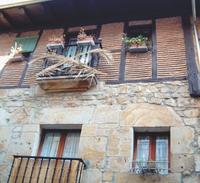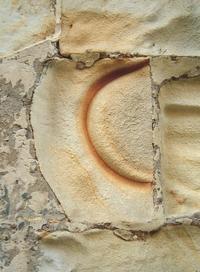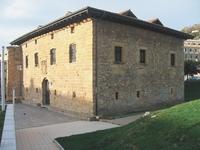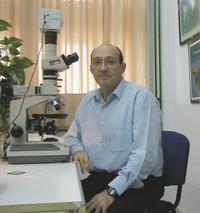Weak beauty of sandstone

In the construction has always been used sandstone in Euskal Herria, it is not something new. It is the typical stone of the quarry. It does not shine, but it has natural beauty. It is formed by cementation proper of the sand, predominating quartz.
Churches, palaces and some beautiful facades are sandstone in the Basque Country. Whitish, yellowish and reddish. The rich in plagioclase or mineral feldspar are white. But in general they are golden and yellowish. Also reddish, many of them with iron oxide cements in the grooves between large grains. These iron oxides, often when the rock deforms, penetrate through the layers of the original mineral, forming various figures or ornaments. And sandstone gets a unique beauty.
Although formerly the sandstone was used for the manufacture of ashlars, nowadays it is generally used as a cover. The buildings are built in brick and concrete, covering the exteriors with sandstones.
The old hamlets of Elorrio and Durangaldea, for their part, are built entirely in sandstone. The villa of Elorrio, for example, is spectacular; the palace of the Renaissance, the church... All of them sandstone. In fact, it can be said that Elorrio is one of the best places to enjoy the beauty of sandstone in Euskal Herria.
Arenisca in Euskal Herria

The Professor of Geology of the Faculty of Science and Technology of Leioa, Patxi García, explained that in Euskal Herria two types of sandstones have been used mainly: Elorrio sandstone and Igeldo sandstone.
The sandstone of Elorrio is quite hard, resistant and very beautiful, striking. Very used in the construction of historical buildings, with good results.
The sandstone of the Tertiary of Igeldo, for its part, is very beautiful but less cemented. Geologically it is younger than the sandstone of Elorrio. Therefore, the amount of sediments on the surface has been reduced, and the compactness between the grains is lower. However, this does not mean that the older the stone, the harder it is, although in this case, the sandstone of Igeldo deteriorates more easily than that of Elorrio. Among them are the XIX. The historical aspects of the twentieth century have been elaborated with sandstones of the Tertiary.
But not everything remains in that beauty. In spite of being the most beautiful of the most beautiful, with time his achaques are presented. Undoubtedly, the degradation that sandstone is suffering in recent years is significant. There is no choice but to visit the aforementioned ancient helmets.

Sandstone 'sick'
Air pollution, transport, demographic growth and climate completely destroy the stone. When it is said that the sandstone of a building is "sick" or deteriorated, we must take into account factors such as the porosity of the stone, the cementation and the matrix, the environmental humidity, the salinity and the pollution.
The minerals of the clay that form the matrix of sandstone, like small microns, etc., compact sandstone. In fact, they are very small and have reaction capacity, and they are often crystallized on the surface of large grains. They form bridges and joints between the grains of sandstone, that is, reinforce the cementation.
On the contrary, other minerals are very unstable, such as feldspar. The feldspores do the opposite. If there is water in the slits, these minerals dissolve and, over time, they completely break down into several fragments.

All this has to do with humidity, more if you consider that the climate of Euskal Herria is very humid. In addition, humidity and salinity are the main enemies of every stone.
In general, the more porous it is, the easier the sandstone is damaged. In the sandstone on the facades, for example, water is very easy to introduce. Once the fog is introduced on the Basque coast, the water of this fog penetrates the pores of the sandstone. This water contains sodium chloride, crystallizes in the pores and expands. And crak! The pores open and the stone deteriorates.
Pollution also has to do with. The particles of air accumulate in the facades of the buildings and become crusts. If that crust does not react with the stone, half evil. The problem arises when it reacts with the rock and enters a certain depth. When this happens, it is necessary to see if the damaged and healthy stone can be united with the binder. The permeability and thickness of the stone will be analyzed, and depending on this the appropriate binder will be selected to apply.
In these Tertiary sandstones, these diseases are usually produced. In other harder and insoluble sandstones, the only problem is surface dirt.

And we must not forget the problem of the vegetation, which grows much because of the climate here. To avoid it, in the treatment of buildings, first apply fungicides. In this way, fungi and shrubs are avoided during a period of time. Only for a time, since the vegetation comes out again. However, the growth of this vegetation is not a serious problem for the conservation of the stone if it is controlled.
The real problem is the one caused by water. In most of the saddle boards, water has been introduced, filled with dust and dirt. The disaster of the sandstone of the buildings must somehow remain.
In this sense, the College of Spanish Architects does not recommend the use of sandstones in construction. Thus, in the main catalogs, sandstone is not recommended as building material, since it generates many problems. However, this does not mean that it will not be used in the future or that the architects do it at all. In fact, it is very used by the architects. It has magnificent views and colors, besides being a stone within reach of many places. However, it must be taken into account, among other things, that the form and porosity referred to in the granule are a problem.









